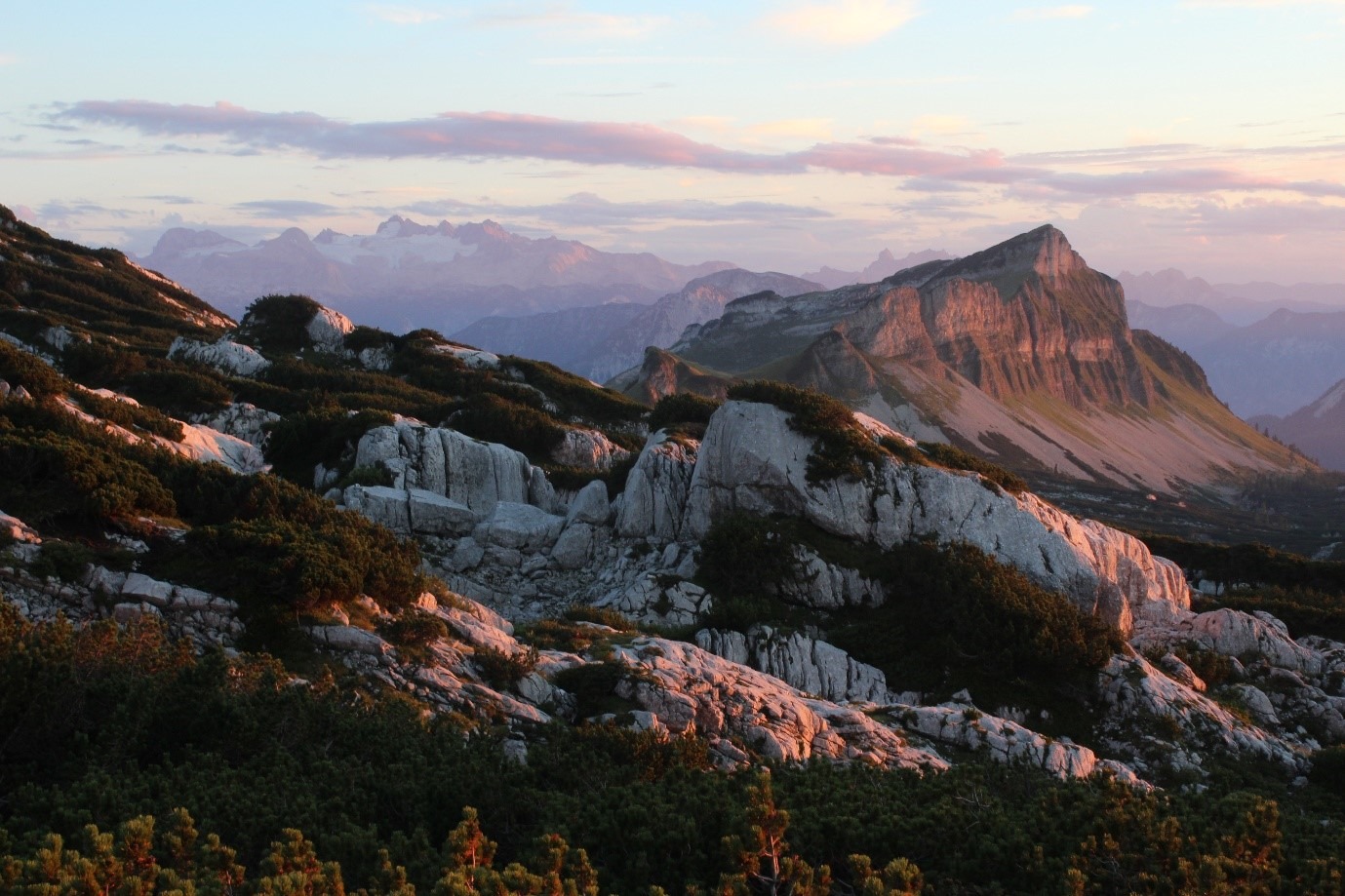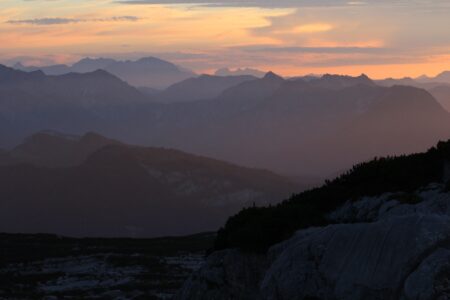The following narrative by Alice Shackley recounts the first-hand experiences of her first caving expedition with the Cambridge University Caving Club. Alice was the recipient of an Alex Pitcher Award from the Ghar Parau Foundation – a grant awarded to enthusiastic young cavers going on their first expedition abroad.
My first impression of the CUCC expo (Austria), just from talk, was that it would be hard. The caves were cold, the walk up the hill was challenging and although base camp had showers, a bread maker and a deep fat fryer, a large portion of my time would be spent up on the plateau, at top camp, without fresh food or a real toilet. So from before I even left the UK I knew it was going to be a tough few weeks.
I travelled out to Austria by car driven the entire way by Mike. (I felt somewhat bad about this but as I can’t drive there wasn’t much I could do to help). We arrived on Monday the 31st of August, approximately week 4 of the expedition, rearing and ready to go. As everyone said the walk took 2 hours up the hill I prepared my unfit self for a 3 hour slog which we started at sunset that evening. I felt like my bag weighed a tonne and five minutes after leaving the car park I was already wondering why I had agreed to this. The views as we walked were incredible and the further we went the better they got. Sadly my ability to walk uphill didn’t improve so I pulled everyone to a slow pace and 2 hours 45 minutes later, in the dark, we finally arrived at base camp. I was pretty exhausted but honestly couldn’t have been happier that the worst walk of the entire expedition was over. From there I figured I could cope. And I did.
Top camp can be a pretty harsh environment but I was lucky enough to arrive in a spout of good weather which definitely made it nicer. The 30 degree heat had me in my element and I enjoyed being able to comfortably wear shorts for the first few days.
My first caving trip was down Balkonhöhle and it turned out to be relatively eventful for what was deemed a tourist trip. I very much enjoyed the SRT on the entrance series and marvelled at the ice formations in the Tunnocks-Balkonhöhle connection aven but as three of us headed out a few hours later we heard the sudden rush of a flood pulse coming from above. The sound started just as I had weighted a rope for a small 10m pitch so I hurried to get down. (Admittedly I didn’t do this very well and I was incredibly thankful that I was small enough to simply be picked up by Michael so I could take off my jammers – lesson learnt for next time). We weren’t sure where the water would appear from so we retreated down the passage and waited. A minute later we heard the water falling on the other side of the chamber creating a small waterfall and a minute or two after that we decided it was okay to go up the rope as long as we didn’t hang about. It wasn’t long before we were at the top of the pitch and our minds turned to other people to be worried about. The top priority was Corin, who had headed out ahead of us with some extra rope.
The entrance series of Balkonhöhle is known to flood in thunderstorms, so much so that a group shelter (also called a bothy) is always left at the bottom of the pitches so that the rain can be waited out. Thankfully we found our man sat singing to himself under the bright orange cover of the bothy. He had been caught in a similar position on the end of the rope but had also gotten off okay (probably in a better manner than myself) and had since been waiting for us to turn up. The entrance series round the corner definitely sounding wet so we wasted no time putting on our extra layers and arranging tackle sacks and rope to sit on under the group shelter. We sat and chatted for the next 3 hours which went by relatively quickly. Our talk was occasionally interrupted for a game of “guess how much time has passed” but mostly it was a great opportunity to get to know my fellow cavers better. By the time we were happy to get going our call-out was at risk so the fastest of us, Rachel, went ahead to reassure camp that we were fine and extend the call-out by an hour. It was the longest trip I had ever done underground (11 hours) and definitely gave me experiences I’ve learnt from and won’t forget.
The following adventures underground were almost all to the newly discovered Fischgesichthöhle, a cave known for a strong draft and a lot of ice. Hearing of this I went prepared in three sets of thermals, a furry, fleece, 3 pairs of socks, 2 buffs, 2 pairs of gloves and a hat. In all honesty it didn’t stop my extremities getting cold but the excitement of unexplored cave kept me going back. The short walk through the entrance lead to a 15 m pitch, the bottom of which had quite a few promising leads. The “windy tunnel” was my first bit of surveying and I had the delight of trying to record all the details as I offered to be on book. My third trip into Fischgesichthöhle gave me another first – bolting, the idea of which had very much scared me up until this point. I practised under supervision on a nice bit of ramp which needed a line as it later became too steep. This came in handy as on one of the last pushing trips into this cave I put my practice into action bolting a 35m pitch going from a rift into a massive canyon. Nothing has terrified me so much in caving before, particularly with my fear of heights, so the sense of achievement was incredible. Surveying the passage then meant I got to achieve one of my greatest aims of the trip, naming a bit of cave.
The moment that stuck with me was when I was sat in my harness at the top of the pitch, looking down into the canyon with my surveying partner, Mike, 35 m below me. The first time the DISTO laser was pointed down there, the reading had come back as 25 m. This was due to a shelf that was formed 10 m above the floor where an active stream ran. The water had clearly cut through this thin bit of rock leaving behind a long, narrow gap, following the path of the water. From my position above this gap was then illuminated from Mike’s light below, a bright line striking through the dark of the canyon. To me it looked like a lightning bolt and so a few days later, sat in front of the expo computer, I named the canyon “Blitzen Boulevard”; ‘blitzen’ being German for ‘lightning’.
Through the three weeks in Austria there were a few things that I managed to achieve but one of the best was my change in fitness. After a week I had already managed to get up the hill in just 2 hours and by the end of the expedition I had shaved that down to 1 hour 40 minutes. The walk to Fischgesichthöhle started at 1 hour 30 minutes, two weeks later it was down to just 25 minutes. (This was partly due to learning the route but practicing carrying my SRT kit everywhere was certainly making a difference). The final trip I did was back down Balkonhöhle where I helped derig the entrance series. I prusiked up the 70 m with an 85 m rope attached to me and still managed to reduce my exit time by 15 minutes compared to the first trip I did. I was thrilled. The hardest part of expo and the thing I had been most concerned about was the demanding exercise yet somehow I’d managed cope and the improvements were fantastic.
Another challenge towards the end of the expedition was the derigging of ‘Cathedral Chasm’. Having started caving less than a year ago (approximately 8 months) I had only ever derigged a cave once and had only practiced a couple of times during training at the indoor climbing wall. Normally this would have affected my confidence quite severely but as I had already spent two weeks caving I agreed to help derig a pitch series which had been created entirely on naturals. It was definitely tougher than had been expected although before I went down no-one was even sure how many deviations or rebelays there were meant to be. The first deviation required quite a jump but I didn’t let it put me off and carried on down. 2 more deviations, 3 rebelays and a concerning amount of rope-rub later, I could see the end of the rope. However the inventive rigging had me stumped as I found myself almost strung-up between two bolts and what looked like a free-hanging traverse line over a 7m pitch. I tried a number of techniques to continue on but with limited time and knowledge I eventually decided that it would be unwise to attempt to get across to the last bolt.
Prusiking up was another task in itself as I knew I had passed a point where the rope was definitely rubbing and showing it despite only one other person having come down before me. I was therefore careful in the way I moved back up and was glad to have remained calm and held my nerve until I finally came off the rope at the top. I was certainly disappointed in not having managed to complete our trip objective but after explaining to others and further consideration it was clear that some chord was probably needed at the very least to get back safely from the last bolt. I had considered this whilst trying to get to the bottom of the pitch and so I was consoled in knowing that my efforts weren’t entirely wasted as I had found out what others would need to be able to do the job correctly.
Overall my experiences at expedition were like nothing I could have had in the UK and certainly weren’t like anything I could have imagined only two or three years ago. The incredible caves were matched by the beautiful scenery and my last triumph was a stunning sunset (or two) which I managed to photograph from top camp where it felt like you were a million miles from civilisation.
Text & photos: Alice Shackley
Summary Expedition Report


